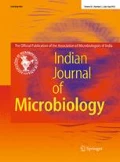Abstract
Ten compounds (1–10) were obtained from soil-derived Penicillium cremeogriseum W1-1 with the antimicrobial guided isolation procedure. Among them, 4 presented broad-spectrum antimicrobial activities and its preliminary mechanisms were evaluated. Compound 4 showed growth inhibition on drug-resistant pathogenic strains Escherichia coli and Candida albicans with post-contact effect (PCE), changed the morphology and membrane structure, killed cells with leakage, inhibited the growth of C. albicans by eradicating biofilms. Interestingly, the fraction containing 4 presented in vivo anti-pathogenic activities in mice, indicating this indole diterpenoid alkaloid could been used as potential antimicrobial agent.


Availability of data
The respiratory hospitalisation data were provided confidentially by Public Health Scotland (PHS), and others would need to apply to them to access the data.
References
Zhang F et al. "A marine microbiome antifungal targets urgent-threat drug-resistant fungi." Sci. 370. https://doi.org/10.1126/science.abd6919
Iranshahi M et al (2015) Protective effects of flavonoids against microbes and toxins: The cases of hesperidin and hesperetin. Life Sci. https://doi.org/10.1016/j.lfs.2015.07.014
Miao CP et al (2016) Rhizospheric fungi of Panax notoginseng: diversity and antagonism to host phytopathogens. J Ginseng Res 40(2):127–134. https://doi.org/10.1016/j.jgr.2015.06.004
Kawahara T et al (2012) JBIR-137 and JBIR-138, new secondary metabolites from Aspergillus sp. fA75. J Antibiot 65(10):535. https://doi.org/10.1038/ja.2012.64
MUNDAY-FINCH SC, et al (1996) Isolation of paspaline B, an indole-diterpenoid from Penicillium paxilli. Phytochem 41(16):327–332. https://doi.org/10.1016/j.physleta.2005.01.027
Yamaguchi T et al (1993) Indoloditerpenes related to tremorgenic mycotoxins, penitrems, from Penicillium crustosum. Phytochem 32(5):1177–1181. https://doi.org/10.1016/S0031-9422(00)95087-8
Fan Y et al (2013) "Indole-Diterpenoids with Anti-H1N1 Activity from the Aciduric Fungus Penicillium camemberti OUCMDZ-1492." J Nat Prod 76(7): 1328–1336. https:// doi.org/https://doi.org/10.1021/np400304q
Zhao JC et al (2018) "Indole diterpenoids from the endophytic fungus Drechmeria sp. as natural antimicrobial agents." Phytochem 148: 21. https://doi.org/10.1016/j.phytochem.2018. 01.010
Torres S et al (2016) Steroidal composition and cytotoxic activity from fruiting body of Cortinarius xiphidipus. Nat Prod Res. https://doi.org/10.1080/14786419.2016.1185717
Hu XJ (2014) "A New Indole Alkaloid from the Fruits of Capparis masaikai." Asian J Chemi 26(14): 4504–4506. https://doi.org/10.14233/ajchem.2014.17486
Yu Jin Hai,Yu Shu Juan,Liu Kai Lu,Wang Chao,Liu Chao,Sun Jin yue,Zhang Hua (2021) Cytotoxic ergostane-type steroids from Ganoderma lingzhi[J]. Steroids.165. https://doi.org/10.1016/j.steroids.2020.108767
Wang J et al (2002) Brefeldin A, a cytotoxin produced by Paecilomyces sp. and Aspergillus clavatus isolated from Taxus mairei and Torreya grandis. FEMS Immunol Med Microbiol. https://doi.org/10.1016/S0928-8244(02)00346-2
Gao X et al (2009) Isolation and purification of macrocyclic components from Penicillium fermentation broth by high-speed counter-current chromatography. WILEY-V C H VERLAG GMBH. https://doi.org/10.1002/jssc.200900630
Sallam AA et al (2013) ChemInform abstract: indole diterpene alkaloids as novel inhibitors of the Wnt/β-catenin pathway in breast cancer cells. Eur J Med Chem 70C(19):594–606. https://doi.org/10.1002/chin.201419221
Taraszkiewicz A et al (2012) Innovative strategies to overcome biofilm resistance. Biomed Res Int. https://doi.org/10.1155/2013/150653
Acknowledgements
This work was supported financially by the National Natural Science Foundation of China (No. 81760632, 31660532, 81660582). The authors are grateful to introduced talents grand of Yunnan University (to Xiao-Dong Luo) and Yunnan Major Science and Technology Project (2019FY003004 and 2019ZF003) for financial support.
Author information
Authors and Affiliations
Corresponding authors
Ethics declarations
Conflict of interest
The authors declare that they have no conflict of interest.
Additional information
Publisher's Note
Springer Nature remains neutral with regard to jurisdictional claims in published maps and institutional affiliations.
Supplementary Information
Below is the link to the electronic supplementary material.
Rights and permissions
About this article
Cite this article
Sang, XY., Wang, ZJ., Yang, YB. et al. Antimicrobial Natural Products Produced by Soil-Derived Fungus Penicillium cremeogriseum W1-1. Indian J Microbiol 61, 519–523 (2021). https://doi.org/10.1007/s12088-021-00957-z
Received:
Accepted:
Published:
Issue Date:
DOI: https://doi.org/10.1007/s12088-021-00957-z

